Related Research Articles
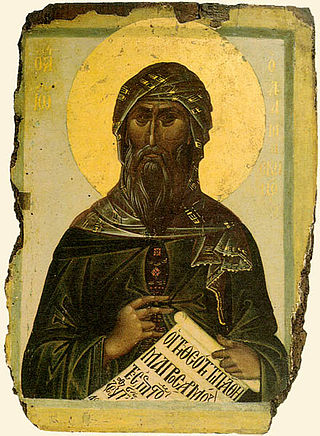
John of Damascus or John Damascene was an Arab Christian monk, priest, hymnographer, and apologist. Born and raised in Damascus c. 675 or 676; the precise date and place of his death is not known, though tradition places it at his monastery, Mar Saba, near Jerusalem on 4 December 749.

A martyr is someone who suffers persecution and death for advocating, renouncing, or refusing to renounce or advocate, a religious belief or other cause as demanded by an external party.
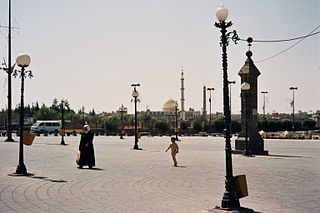
Bosra, formerly Bostra and officially called Busra al-Sham, is a town in southern Syria, administratively belonging to the Daraa District of the Daraa Governorate and geographically part of the Hauran region.
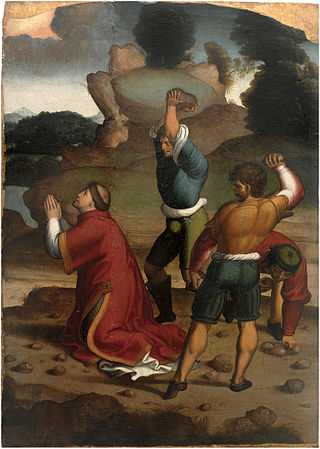
In Christianity, a martyr is a person who was or is killed for their testimony for Jesus or faith in Jesus. In years of the early church, stories depict this often occurring through death by sawing, stoning, crucifixion, burning at the stake, or other forms of torture and capital punishment. The word martyr comes from the Koine word μάρτυς, mártys, which means "witness" or "testimony".
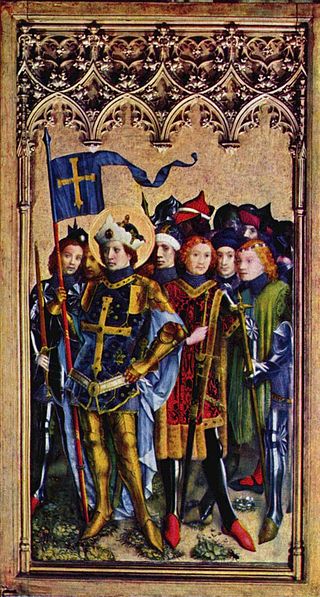
The Theban Legion figures in Christian hagiography as a Roman legion from Egypt —"six thousand six hundred and sixty-six men" — consisting of Christian soldiers who were martyred together in 286, according to the hagiographies of Maurice, the chief among the Legion's saints. Their feast day is held on September 22.

The Holy Lavra of Saint Sabbas, known in Arabic and Syriac as Mar Saba and historically as the Great Laura of Saint Sabas, is a Greek Orthodox monastery overlooking the Kidron Valley in the Bethlehem Governorate of Palestine, in the West Bank, at a point halfway between Bethlehem and the Dead Sea. The monks of Mar Saba and those of subsidiary houses are known as Sabaites.

The Martyrs of Córdoba were forty-eight Christian martyrs who were executed under the rule of Muslim administration in Al-Andalus. The hagiographical treatise written by the Iberian Christian and Latinist scholar Eulogius of Córdoba describes in detail the executions of the martyrs for capital violations of Islamic law (sharīʿa), including apostasy and blasphemy. The martyrdoms recorded by Eulogius took place between 850 and 859 AD, which according to the Mālikī judges of al-Andalus broke the treaty signed between Muslims and their Christian subjects.
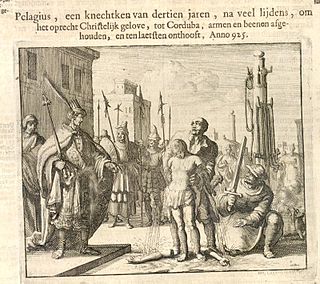
Pelagius of Córdoba was a Christian boy who died as a martyr in Córdoba in southern Spain around 926 AD.

Acts of the Martyrs are accounts of the suffering and death of a Christian martyr or group of martyrs. These accounts were collected and used in church liturgies from early times as attested by Saint Augustine.

Seeing Islam As Others Saw It: A Survey and Evaluation of Christian, Jewish and Zoroastrian Writings on Early Islam from the Studies in Late Antiquity and Early Islam series is a book by scholar of the Middle East Robert G. Hoyland.

Saint Stephen the Sabaite, also known as Stephen the Hymnographer, was a Christian monk from Julis, Gaza, a district of Gaza. He was a nephew of St. John of Damascus and spent a half-century in the monastery of Mar Saba. He is venerated as a saint in the Eastern Orthodox Church.

Sabbas the Goth was a Christian martyr venerated as a saint.

Saint Anastasius of Persia, also known by his native name Magundat, was a Zoroastrian soldier in the Sasanian army who later became a convert to Christianity and was martyred in 628.
The title of New Martyr or Neomartyr is conferred in some denominations of Christianity to distinguish more recent martyrs and confessors from the old martyrs of the persecution in the Roman Empire. Originally and typically, it refers to victims of Islamic persecution.
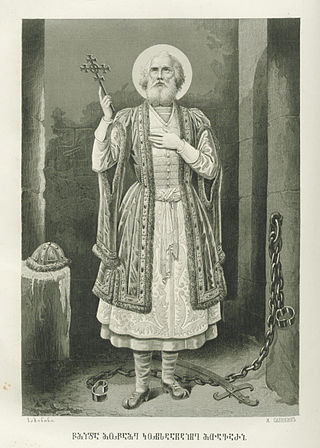
Konstanti Kakhay or Konstanti Kakhi was a Christian Georgian nobleman from Kartli, who was seized captive by the Abbasid general Bugha al-Kabir during his 853 expedition into the Caucasus. He was subsequently put to death, at the age of 85, for refusing to convert to Islam. This made Kostanti a subject of the contemporaneous hagiography and a saint of the Georgian Orthodox Church.
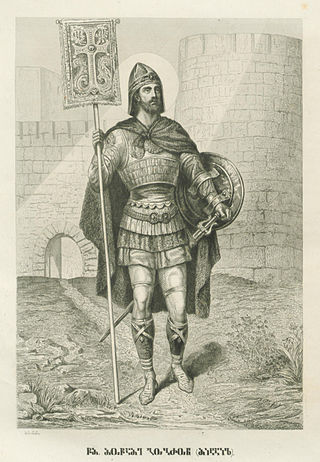
Gobron also known as Mikel-Gobron or Michael-Gobron (მიქელ-გობრონი) was a Christian Georgian military commander who led the defense of the fortress of Q'ueli against the Sajid emir of Azerbaijan. When the fortress fell after a 28-day-long siege, Gobron was captured and beheaded, having rejected inducements to convert to Islam. Shortly after his death Gobron became the subject of the hagiography authored by Bishop Stephen of T'beti and a saint of the Georgian Orthodox Church, which commemorates him on November 17. His martyrdom is also mentioned by the medieval Georgian and Armenian chronicles.

Elias of Heliopolis, also called Elias of Damascus, was a Syrian carpenter and Christian martyr revered as a saint in the Eastern Orthodox and Syriac Orthodox churches. He is known from a Greek hagiography.
The Passion of the Sixty Martyrs of Gaza is a hagiography text pertaining to the martyrdom of sixty Byzantine soldiers at Gaza. Contrary to many hagiographies which martyrs were killed for religious reasons, martyrs had also died for either military, political, or non-religious reasons such as in the Passion of the Sixty Martyrs of Gaza. Palestine 's history during Muslim conquest in the Greek original Passion of the Sixty Martyrs of Gaza contains unique details of significant events along with Jerusalem's early occupation by the Muslims. The text is also an early witness to many of these events predating Theophilus of Edessa, even contradicting him such as Gaza's surrender on a different date and Sophronius's circumstances leading to his death.
Michael Synkellos, also spelled Syncellus, was a Greek Orthodox Arab Christian priest, monk and saint. He held the administrative office of synkellos of the patriarchate of Jerusalem (c. 811–815) and the patriarchate of Constantinople (843–846). He was involved in disputes over the filioque clause and over Byzantine iconoclasm, which landed him in prison for the period 815–843. He nevertheless wrote extensively, producing grammar, theology, hagiographies, hymns and poetry. He wrote in Greek and made at least one translation from Arabic.
Leontius of Damascus was a Syrian monk who wrote a biography in Greek of his teacher, Stephen of Mar Saba. It emphasises Stephen's asceticism and thaumaturgy (miracle-working), but is also a rich source for the history of Palestine in the eighth century. It has been translated into English.
References
- ↑ Roman Martyrology
- ↑ A New Dictionary of the Saints: East and West, by Michael J. Walsh
- ↑ Sahner, Christian C. (2020) Christian Martyrs Under Islam: Religious Violence and the Making of the Muslim World, p. 167.
- ↑ Hugh N. Kennedy, The Byzantine and Early Islamic Near East, Ashgate Publishing 2006, p. 333.
- 1 2 Stephen J. Shoemaker, ed., Three Christian Martyrdoms from Early Islamic Palestine: Passion of Peter of Capitolias, Passion of the Twenty Martyrs of Mar Saba, Passion of Romanos the Neo-Martyr (Brigham Young University Press, 2016; published online by Brill, 2019), pp. xv–xxx.